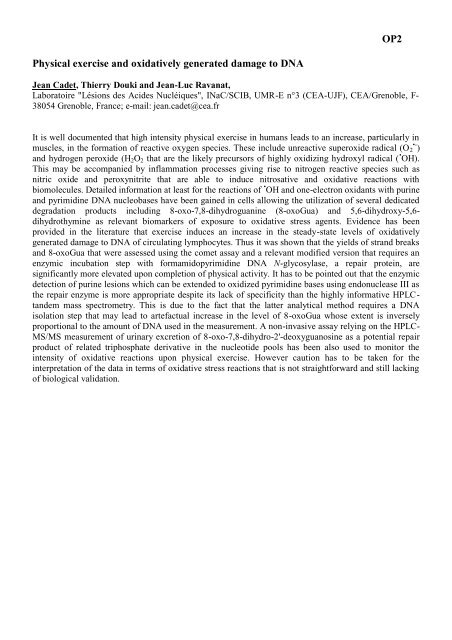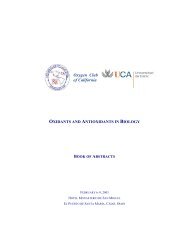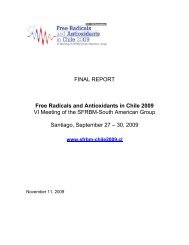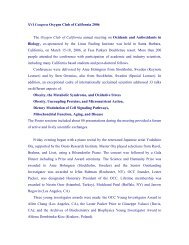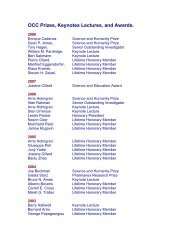PROGRAMME SCIENTIFIQUE - Oxygen Club of California
PROGRAMME SCIENTIFIQUE - Oxygen Club of California
PROGRAMME SCIENTIFIQUE - Oxygen Club of California
Create successful ePaper yourself
Turn your PDF publications into a flip-book with our unique Google optimized e-Paper software.
OP2<br />
Physical exercise and oxidatively generated damage to DNA<br />
Jean Cadet, Thierry Douki and Jean-Luc Ravanat,<br />
Laboratoire "Lésions des Acides Nucléiques", INaC/SCIB, UMR-E n°3 (CEA-UJF), CEA/Grenoble, F-<br />
38054 Grenoble, France; e-mail: jean.cadet@cea.fr<br />
It is well documented that high intensity physical exercise in humans leads to an increase, particularly in<br />
muscles, in the formation <strong>of</strong> reactive oxygen species. These include unreactive superoxide radical (O 2 •- )<br />
and hydrogen peroxide (H 2 O 2 that are the likely precursors <strong>of</strong> highly oxidizing hydroxyl radical ( • OH).<br />
This may be accompanied by inflammation processes giving rise to nitrogen reactive species such as<br />
nitric oxide and peroxynitrite that are able to induce nitrosative and oxidative reactions with<br />
biomolecules. Detailed information at least for the reactions <strong>of</strong> • OH and one-electron oxidants with purine<br />
and pyrimidine DNA nucleobases have been gained in cells allowing the utilization <strong>of</strong> several dedicated<br />
degradation products including 8-oxo-7,8-dihydroguanine (8-oxoGua) and 5,6-dihydroxy-5,6-<br />
dihydrothymine as relevant biomarkers <strong>of</strong> exposure to oxidative stress agents. Evidence has been<br />
provided in the literature that exercise induces an increase in the steady-state levels <strong>of</strong> oxidatively<br />
generated damage to DNA <strong>of</strong> circulating lymphocytes. Thus it was shown that the yields <strong>of</strong> strand breaks<br />
and 8-oxoGua that were assessed using the comet assay and a relevant modified version that requires an<br />
enzymic incubation step with formamidopyrimidine DNA N-glycosylase, a repair protein, are<br />
significantly more elevated upon completion <strong>of</strong> physical activity. It has to be pointed out that the enzymic<br />
detection <strong>of</strong> purine lesions which can be extended to oxidized pyrimidine bases using endonuclease III as<br />
the repair enzyme is more appropriate despite its lack <strong>of</strong> specificity than the highly informative HPLCtandem<br />
mass spectrometry. This is due to the fact that the latter analytical method requires a DNA<br />
isolation step that may lead to artefactual increase in the level <strong>of</strong> 8-oxoGua whose extent is inversely<br />
proportional to the amount <strong>of</strong> DNA used in the measurement. A non-invasive assay relying on the HPLC-<br />
MS/MS measurement <strong>of</strong> urinary excretion <strong>of</strong> 8-oxo-7,8-dihydro-2'-deoxyguanosine as a potential repair<br />
product <strong>of</strong> related triphosphate derivative in the nucleotide pools has been also used to monitor the<br />
intensity <strong>of</strong> oxidative reactions upon physical exercise. However caution has to be taken for the<br />
interpretation <strong>of</strong> the data in terms <strong>of</strong> oxidative stress reactions that is not straightforward and still lacking<br />
<strong>of</strong> biological validation.


